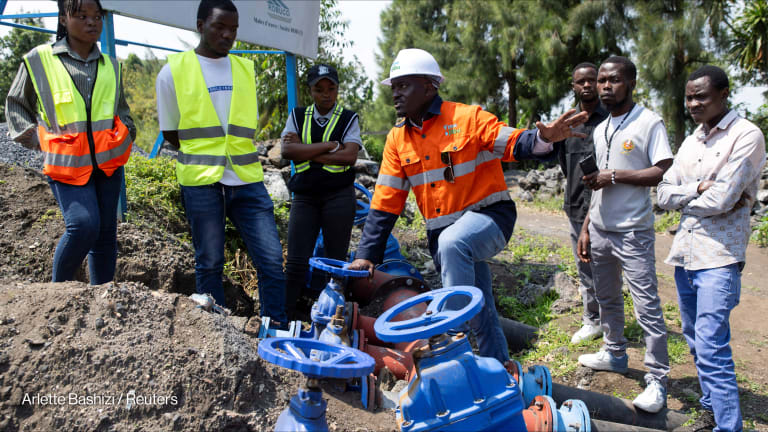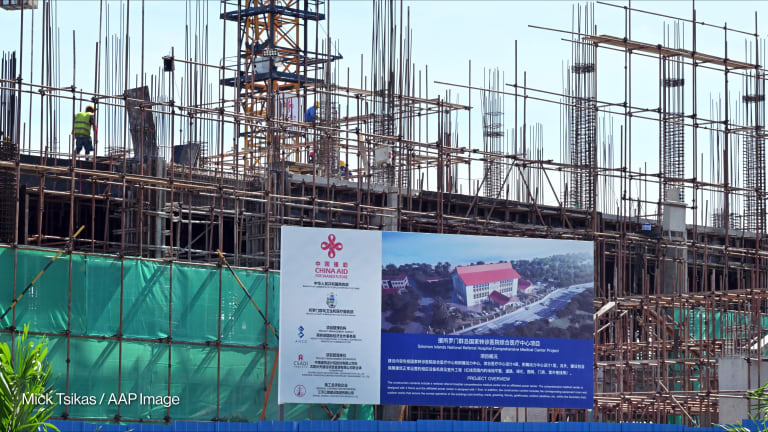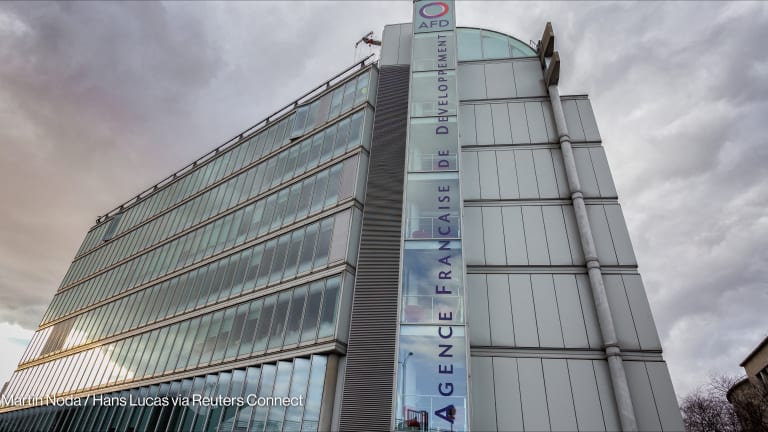What did the Global Environment Facility spend $6.4 billion on?
Between 2021 and 2025, the multilateral facility approved 1,162 projects across five key areas.
As we mark the beginning of the 30th United Nations Climate Change Conference, or COP30, Devex took a deep dive into one of the world’s largest sources of multilateral environmental funds, the Global Environment Facility, or GEF, to understand how it works and identify what its priorities are. GEF is an independent multilateral facility established in 1991, with the backing of major institutional donors, to fund environmental causes. To date, GEF has provided over $26 billion and mobilized another $153 billion in cofinancing to support projects in five key areas: biodiversity, chemicals and waste, climate change, international waters, and land degradation. Between 2021 and 2025, the multilateral facility has approved 1,162 projects, with a total grant amount of $6.4 billion. In this analysis, we focused on this five-year period to see where the money is going. What is GEF, and how does it fund environmental projects? GEF consolidates six multilateral funds, each of which addresses different but interrelated environmental challenges. Based on our findings, the largest among them is the GEF Trust Fund, which accounted for 84% of the total financing for the approved projects between 2021 and 2025, worth $5.4 billion. The Least Developed Countries Fund ranked next among the six funds, with $666.2 million, followed by the Global Biodiversity Framework Fund, with $73.9 million, then the Special Climate Change Fund, with $24.6 million, and the Capacity-building Initiative for Transparency Trust Fund, with $2.1 million. Another $228.1 million came from two or more funds, which is labeled in the dataset as “Multi Trust Fund.” Meanwhile, the Nagoya Protocol Implementation Fund, which is also among the six funds, did not have any approved funding for the time period we examined. As previously mentioned, GEF mobilizes additional funding for its projects. Based on our review, the approved projects between 2021 and 2025 brought another $45.3 billion in cofinancing. However, the data did not specify the co-donors and the exact breakdown of their contributions. Where does GEF invest its money? Based on our analysis, 896 of the 1,162 approved projects between 2021 and 2025 are single-country activities. Meanwhile, the remaining 266 projects, worth $1.9 billion, are global, regional, or multicountry projects. China is the overall top recipient of single-country projects, worth $228.2 million, or 3.6% of total approved GEF grants in the time period. The largest among these is the World Bank-implemented Green and Carbon Neutral Cities, which aims to integrate biodiversity conservation into urban development in selected cities in China. The project received a $26.9 million grant from GEF and an additional $300.7 million through cofinancing. Brazil ranked next with $198.8 million, with the biggest project — worth $24.6 million in GEF grants and $172 million in cofinancing — supporting land management, value chains, and conservation activities. Mexico is also among the biggest recipients of GEF projects, worth $158.7 million. Its top project, worth $16.7 million, will provide long-term financing for its national protected areas. The other top recipients of GEF grants were: Indonesia, with $147.7 million; India, with $137.1 million; and Peru, with $109.6 million. <div class='tableauPlaceholder' id='viz1762762565576' style='position: relative'><noscript><a href='#'><img alt='GEF projects by recipient ' src='https://public.tableau.com/static/images/B8/B82D7NK83/1_rss.png' style='border: none' /></a></noscript><object class='tableauViz' style='display:none;'><param name='host_url' value='https%3A%2F%2Fpublic.tableau.com%2F' /> <param name='embed_code_version' value='3' /> <param name='path' value='shared/B82D7NK83' /> <param name='toolbar' value='yes' /><param name='static_image' value='https://public.tableau.com/static/images/B8/B82D7NK83/1.png' /> <param name='animate_transition' value='yes' /><param name='display_static_image' value='yes' /><param name='display_spinner' value='yes' /><param name='display_overlay' value='yes' /><param name='display_count' value='yes' /><param name='language' value='en-US' /><param name='filter' value='publish=yes' /><param name='device' value='desktop' /><param name='showShareOptions' value='false' /></object></div> <script type='text/javascript'> var divElement = document.getElementById('viz1762762565576'); var vizElement = divElement.getElementsByTagName('object')[0]; if ( divElement.offsetWidth > 800 ) { vizElement.style.width='100%';vizElement.style.height=(divElement.offsetWidth*0.75)+'px';} else if ( divElement.offsetWidth > 500 ) { vizElement.style.width='100%';vizElement.style.height=(divElement.offsetWidth*0.75)+'px';} else { vizElement.style.width='100%';vizElement.style.height='727px';} var scriptElement = document.createElement('script'); scriptElement.src = 'https://public.tableau.com/javascripts/api/viz_v1.js'; vizElement.parentNode.insertBefore(scriptElement, vizElement); </script> <i style=font-style: georgia;”>Geographical distribution of GEF’s approved projects between 2021 and 2025, based on its portal.</i> What are GEF’s sectoral priorities? Of the 1,162 approved projects, 811 projects have a single target sector, while the remaining 351 are multisectoral. Among those with a lone sectoral focus, climate change came out as the priority, with almost $1.3 billion in GEF funding, or 19.9% of the total. Biodiversity ranked next, with $985.7 million; chemicals and waste, with $591.6 million; international waters, with $468.5 million; and then land degradation, with $168.8 million. Meanwhile, six projects — worth $113.3 million — have no specified target sector. We also counted the number of times a sector is tagged in a project, which may be useful in identifying priorities, especially for those projects with multiple target areas. Based on our review, climate change is either the sole target sector or among the priorities in 570 of the 1,162 active projects between 2021 and 2025. Biodiversity ranked next, having been tagged 511 times; followed by land degradation, with 339; international waters, with 133; then chemicals and waste, with 122. <div class='tableauPlaceholder' id='viz1762762654014' style='position: relative'><noscript><a href='#'><img alt='GEF projects by sectors ' src='https://public.tableau.com/static/images/GE/GEFprojectsbysectors/GEFprojectsbysectors/1_rss.png' style='border: none' /></a></noscript><object class='tableauViz' style='display:none;'><param name='host_url' value='https%3A%2F%2Fpublic.tableau.com%2F' /> <param name='embed_code_version' value='3' /> <param name='site_root' value='' /><param name='name' value='GEFprojectsbysectors/GEFprojectsbysectors' /><param name='tabs' value='no' /><param name='toolbar' value='yes' /><param name='static_image' value='https://public.tableau.com/static/images/GE/GEFprojectsbysectors/GEFprojectsbysectors/1.png' /> <param name='animate_transition' value='yes' /><param name='display_static_image' value='yes' /><param name='display_spinner' value='yes' /><param name='display_overlay' value='yes' /><param name='display_count' value='yes' /><param name='language' value='en-US' /><param name='filter' value='publish=yes' /><param name='device' value='desktop' /><param name='showShareOptions' value='false' /></object></div> <script type='text/javascript'> var divElement = document.getElementById('viz1762762654014'); var vizElement = divElement.getElementsByTagName('object')[0]; if ( divElement.offsetWidth > 800 ) { vizElement.style.width='100%';vizElement.style.height=(divElement.offsetWidth*0.75)+'px';} else if ( divElement.offsetWidth > 500 ) { vizElement.style.width='100%';vizElement.style.height=(divElement.offsetWidth*0.75)+'px';} else { vizElement.style.width='100%';vizElement.style.height='727px';} var scriptElement = document.createElement('script'); scriptElement.src = 'https://public.tableau.com/javascripts/api/viz_v1.js'; vizElement.parentNode.insertBefore(scriptElement, vizElement); </script> <i style=font-style: georgia;”>Sectoral distribution of GEF’s approved projects between 2021 and 2025, based on its portal.</i> Who implements GEF projects? According to its website, GEF has 18 partner agencies that help develop and implement its projects across the globe. The data shows that the bulk of GEF’s approved projects in the five-year period were implemented by a single agency. Among them, the United Nations Development Programme accounted for nearly 30% of the total approved funding between 2021 and 2025, worth almost $1.9 billion. The Food and Agriculture Organization followed, with $1 billion, then the United Nations Environment Programme, with $902.2 million, and the World Bank, with $592.7 million. <div class='tableauPlaceholder' id='viz1762762766364' style='position: relative'><noscript><a href='#'><img alt='All GEF projects ' src='https://public.tableau.com/static/images/Al/AllGEFprojects/AllGEFprojects/1_rss.png' style='border: none' /></a></noscript><object class='tableauViz' style='display:none;'><param name='host_url' value='https%3A%2F%2Fpublic.tableau.com%2F' /> <param name='embed_code_version' value='3' /> <param name='site_root' value='' /><param name='name' value='AllGEFprojects/AllGEFprojects' /><param name='tabs' value='no' /><param name='toolbar' value='yes' /><param name='static_image' value='https://public.tableau.com/static/images/Al/AllGEFprojects/AllGEFprojects/1.png' /> <param name='animate_transition' value='yes' /><param name='display_static_image' value='yes' /><param name='display_spinner' value='yes' /><param name='display_overlay' value='yes' /><param name='display_count' value='yes' /><param name='language' value='en-US' /><param name='filter' value='publish=yes' /><param name='device' value='desktop' /><param name='showShareOptions' value='false' /></object></div> <script type='text/javascript'> var divElement = document.getElementById('viz1762762766364'); var vizElement = divElement.getElementsByTagName('object')[0]; if ( divElement.offsetWidth > 800 ) { vizElement.style.width='100%';vizElement.style.height=(divElement.offsetWidth*0.75)+'px';} else if ( divElement.offsetWidth > 500 ) { vizElement.style.width='100%';vizElement.style.height=(divElement.offsetWidth*0.75)+'px';} else { vizElement.style.width='100%';vizElement.style.height='727px';} var scriptElement = document.createElement('script'); scriptElement.src = 'https://public.tableau.com/javascripts/api/viz_v1.js'; vizElement.parentNode.insertBefore(scriptElement, vizElement); </script> <i style=font-style: georgia;”>All GEF-approved projects between 2021 and 2025, based on its portal.</i> Try out Devex Pro Funding today with a free five-day trial, and explore funding opportunities from over 850 sources in addition to our analysis and news content.
As we mark the beginning of the 30th United Nations Climate Change Conference, or COP30, Devex took a deep dive into one of the world’s largest sources of multilateral environmental funds, the Global Environment Facility, or GEF, to understand how it works and identify what its priorities are.
GEF is an independent multilateral facility established in 1991, with the backing of major institutional donors, to fund environmental causes. To date, GEF has provided over $26 billion and mobilized another $153 billion in cofinancing to support projects in five key areas: biodiversity, chemicals and waste, climate change, international waters, and land degradation.
Between 2021 and 2025, the multilateral facility has approved 1,162 projects, with a total grant amount of $6.4 billion.
This story is forDevex Promembers
Unlock this story now with a 15-day free trial of Devex Pro.
With a Devex Pro subscription you'll get access to deeper analysis and exclusive insights from our reporters and analysts.
Start my free trialRequest a group subscription Printing articles to share with others is a breach of our terms and conditions and copyright policy. Please use the sharing options on the left side of the article. Devex Pro members may share up to 10 articles per month using the Pro share tool ( ).
Miguel Tamonan is a Senior Development Analyst at Devex, where he analyzes data from public and private donors to produce content and special reports for Pro and Pro Funding readers. He has a bachelor’s degree in Political Science with a Major in International Relations from the Polytechnic University of the Philippines.








